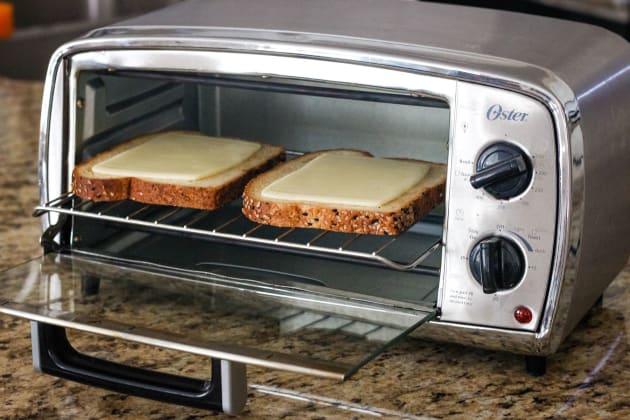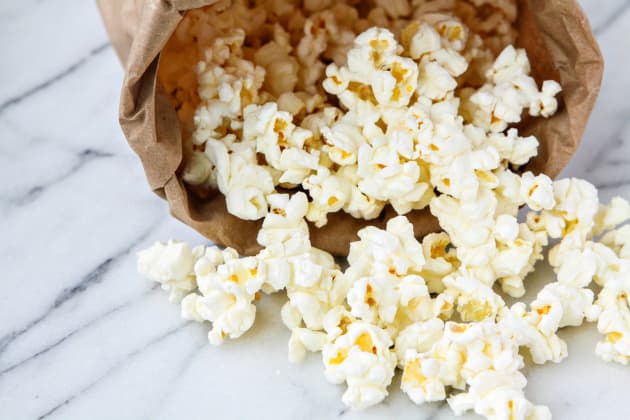Can You Put Styrofoam in the Oven? What to Know
Nicole AustinFollow our safety guide if you want to heat up some restaurant takeout leftovers.
How many times have you used a disposable paper plate that left you feeling like you may as well have just put your meal on a piece of paper?
Flimsy, disposable plates are a pet peeve of mine. I tend to opt for more sturdy and durable options whenever possible, and my favorite among those when searching for disposable plates is plastic.
One of the most infamous forms of food-safe plastic is widely known as Styrofoam.
Styrofoam is a trademarked brand name for polystyrene, or a type of plastic, originally created by the Dow Chemical Company.
It has become the name we use for this form of plastic in our day to day lives.
It’s no secret that in many ways, Styrofoam is an ideal container for foods.
It can also be an environmental nightmare, however, rapidly filling up landfills — which is all the more reason to try and squeeze multiple uses out of it.
Anyone that has ever had takeout (which is probably everyone, right?) will attest to Styrofoam’s ability to keep hot food warm and cold food cool.
Because it is about 95 percent air, it's popular in the building industry in the United States as an insulator.
You will find it in homes, as well as hot coffee cups, beer coolers, and more.
Its lightweight nature also makes it ideal for creating life vests and rafts, as it is buoyant as well as inexpensive.
It stores well, is easy to crush for disposal, and doesn’t lose its integrity with moist or wet foods.
So, you may be wondering, if Styrofoam is so great for food storage, can I use it to heat my food?
And we’ve got all the answers you’ll need.
What is Styrofoam Made Of?
Styrofoam is made out of “styrene,” which is where it gets its unique name.
Styrene is a petroleum-based product that is then refined into polystyrene, a form of plastic.
When additional agents are added and the product is cooled, Styrofoam is formed.
Styrofoam is unfortunately composed of a large amount of non-sustainable ingredients that are considered pollutants and toxins.
Polystyrene is considered the second-highest for negative environmental impact out of all the products in the world, sitting behind only aluminum. Yikes!
Between the manufacturing process, use and disposal, energy consumption, greenhouse gas effects, and environmental effect of polystyrene, it is, without argument, not environmentally friendly.
Despite this, some experts feel that Styrofoam can safely come into contact with food when it is in a solid state.
However, heating plastics can cause chemicals to leach into the food, which over time presents a health risk to humans.
So, you may be wondering…
Is Styrofoam Safe?
The safety of Styrofoam is a controversial topic, with many aspects to consider.
Styrofoam is pretty terrible for the environment.
It is estimated that plastic accounts for 85 percent of marine litter.
It is difficult to repurpose Styrofoam, as it is harder to isolate the compounds used when making it.
For a lesser impact on the environment, Styrofoam and other plastic manufacturers often recommend reusing items rather than recycling them, as they are aware of the complications surrounding this process.
In fact, most recycling facilities are not equipped to handle Styrofoam, so even if it is brought in and sorted, it will generally be thrown out when all is said and done.
In the rare instances that it is recycled, Styrofoam can no longer be considered food safe, so its uses are then limited.
In addition to being nearly impossible to recycle, it is unknown how long it will actually take Styrofoam to degrade.
Experts estimate anywhere from 100 to 1 million years — just one reason to use an alternative material whenever possible.
And this doesn’t mean that Styrofoam is gone after that time.
Styrofoam simply breaks down into smaller pieces, which still contain the same chemicals as it held in its original form.
Exposure to these chemicals is known to be dangerous over time.
There is also a possibility that Styrofoam leaches a small amount of contaminants into your food.
While using it once in a while is likely safe, the dangers of Styrofoam are a cumulative effect.
With repeated exposure, you could build up an unsafe amount of toxins in your body that come from Styrofoam.
The threshold for this is unknown, as most studies regarding the toxicity from direct exposure to Styrofoam are linked to occupational exposure.
Styrofoam is generally considered safe when using it properly on occasion, however, many states and countries are now banning its use, as well as cities like San Francisco.
Can You Put Styrofoam in the Oven?
Styrofoam should not be used to heat items in the oven.
The risk of Styrofoam leaching chemicals into food products when heated is high.
For this reason, experts recommend transferring food from plastic containers such as Styrofoam or EPS foam to an oven safe or microwave-safe container, depending on how you plan to heat them.
There are no EPS products that are safe to heat in an oven.
In addition to the concerns about chemical toxins, Styrofoam will warp or become soft, making it unsafe to contain food if placed in an oven.
Furthermore, Styrofoam may melt or burn.
So to reiterate, you definitely do not want to put it in the oven!
It's a good idea to transfer food to safer materials specifically labeled as an oven-safe container to avoid harmful chemicals, toxic fumes, or other potential health risks from heating up Styrofoam packaging or to-go food containers.
Avoid heating up leftover food in any type of Styrofoam — Styrofoam cups, Styrofoam plates, or any single-use polystyrene containers! — in the oven, even at a low temperature.
Just don't do it.
What Are Some Things You Should Never Put in an Oven?
In addition to EPS/Styrofoam, there are many commonly used food storage or kitchen products that should not be placed in an oven.
Here are some of the more you should avoid:
Wax paper:
Wax paper is not a good replacement for parchment paper in an oven. While they may look similar, wax paper will melt or catch on fire at high temperatures.
Paper products in general:
While much more broad than wax paper, try to think of any paper products as being flammable and dangerous. Paper plates, paper towels, and cardboard are all fire hazards that should never be used in an oven. In other words, take that pizza out of the box to reheat it!
Certain glassware:
When it comes to using glass in an oven, always look for glass that is oven-safe.
Inspect your glassware for any blemishes, cracks, or chips, and never transfer glass from a cold fridge to a hot oven or vice versa.
This will result in thermal shock, which can cause the glass to shatter.
Plastic:
Not only EPS or Styrofoam, but any form of plastic, should not be placed in an oven.
While this may feel obvious by now, bear in mind that plastic on cookware is sometimes harder to see or consider.
For example, plastic handles or knobs are less noticeable than a dish that is entirely plastic.
Wood:
Much like plastic, wood is used as a material for handles or knobs.
Wood is a great choice for stovetop cookware handles as it stays cool and lessens the risk of burns.
However, in the oven, wood can warp, shrink, split, or in the worst-case scenario, catch fire.
For these reasons, wood is not considered oven safe.
Certain nonstick pans:
Follow manufacturer guidelines when determining if your nonstick pan will hold up in the oven.
Some nonstick coatings are oven safe, while others are not.
To avoid an expensive and frustrating mess, do not make assumptions.
Oven racks (when using self-cleaning mode):
Remove your oven racks and wash them by hand when using the self-cleaning mode on your oven.
Can You Put Styrofoam in the Microwave?
Plastic plates and cups are not safe for use in the microwave unless they are labeled microwave safe.
Even then, some people have concerns about any kind of chemicals leaching from plastics when heated.
There is no concrete data that exists that shows that food heated in plastic containers in the microwave is completely safe.
For that reason, many people do not use the microwave to heat any plastics, including microwave-safe EPS.
What Can You Never Put in the Microwave?
Along with Styrofoam, there are several different materials you should never put in the microwave oven.
Paper bags or paper takeout containers:
Unless marked safe for the microwave, such as a popcorn bag, paper bags are not to be used for heating or reheating food.
Brown paper lunch bags and takeout containers release toxins when heated and could easily catch on fire in a microwave.
Additionally, some takeout containers such as Chinese food boxes have a thin metal wire handle that would be a fire hazard in a microwave.
Lightweight plastic:
Grocery bags, takeout bags, and thin containers such as those used for margarine, butter, yogurt, and cottage cheese are not microwave safe.
While it is common and safe to reuse thin plastic containers to hold food, they are only meant for cold storage.
Travel mugs:
Transfer your drink to a glass or porcelain mug to reheat it in the microwave.
Travel mugs, cups, and bottles contain or are made of metal such as stainless steel, or plastic.
Microwaving metal is an obvious no-no, but plastic cups can also suffer from the heat.
The thin layer of insulation can cause cracking or separation and may degrade.
Old or vintage dishes:
Many dishes that are 40 or more years old contain lead or other dangerous components that can leach into food when heat is introduced.
Hot peppers:
Heat from a microwave will release capsaicin in peppers.
This irritant is the same one found in pepper spray (hence where the name originated!).
You will burn your eyes, lungs, and nose if you’re not careful.
Eggs in a shell:
Microwaving an egg in a shell is asking for an explosion.
The steam formed inside an egg that is heated in a microwave has no place to go and will eventually build up enough pressure to make it pop.
Frozen meat:
Frozen meat will heat unevenly in a microwave and can pose serious health and safety concerns for consumers.
Frozen or thawed bottles:
Baby bottles should not be heated in a microwave, nor thawed there. In addition to the microwave potentially zapping beneficial nutrients, the uneven heating can cause hot spots that cannot be felt by the adult holding the bottle.
This could cause burning or scalding of a baby’s throat in an otherwise mild-temperature bottle.
When considering Styrofoam, remember that it may be an excellent product to insulate food, homes, and hot drinks, but is awful for the environment and it’s worth using a more sustainable option whenever possible.
This can also reduce potential health concerns from these foam food containers even with normal use of the common material.
It could be toxic to humans and animals, especially if it is heated or not properly disposed of.
Consumers should use Styrofoam and other plastics at their own risk, and should instead heat food items using glass or other non-toxic containers to be on the safe side.
Nicole is a self-published author of fiction novels, and a lover of food and spending time in the kitchen with her six children. She lives in coastal Maine where she loves exploring new recipes especially those that can save time, money and wow a crowd.
Tags: FAQ, Safety




